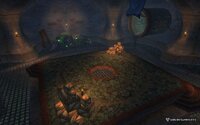“There is no objective in arena matches outside of eliminating the other team. The simple yet majestic beauty of combat wins the day in the arena. There is nothing more here than sword vs. sword, magic vs. magic, and any combustion of tactical offense and defense to create a swirling vortex of insanity and bloodlust.”
In arenas you are stripped down to rely on your own abilities and the synergy you share with your teammates. I constantly hear people complaining about the various problems making their WSG experiences more miserable than enjoyable. I find these complaints silly because there is an obvious solution: arenas.
In arenas, you don’t have to deal with ridiculous outside buffs, 24s, clueless hybrid classes that don’t know how to off heal, mid fighters or GY Farmers. In addition to these obvious benefits, arenas also dramatically increase your individual player ability. You are pushed to your absolute full potential and forced to play at the top of your game with a much smaller margin for error than that that exists in WSG. You work out kinks in your play style and learn to apply skills that you hone in arena to almost every other form PvP.
Table of Contents:
I. Terms
II. Getting to Know Classes
III. Getting to Know the Arenas
IV. Positioning and Situational Awareness
V. Communication
Terms
Before diving right into your first arena there are a few terms that you really need to be familiar with. They are nearly essential to any player versus player situation and are absolutely necessary in arenas.
Faking Casting or Juking: A very simple explanation of fake casting is to intentionally stop casting. The complication to players involves the question, “Well why the hell would I do that? I want my cast to go off.” Although you want the cast to go off, your enemy most likely doesn’t and that’s where fake casting comes into play. By purposely stopping your cast short, you bait out an enemy’s interrupts such as kick or wind shear and allow yourself to finish the cast the next time without being interrupted. Fake casting, in itself, is an art and can take lots of practice and time to master. For tips regarding fake casting, Google is your friend. I suggest downloading the addon interrupt bar and checking out this video that Veinte originally posted in his awesome priest guide:
WoW PvP Commentary | How To Fake Cast in PvP by Skill Capped - YouTube
LoS or “Lining”: LoS stands for Line of Sight. For a cast or spell to go off you need to be within your target’s line of sight. Your opponent cannot be behind a pillar, around a corner or on a different level of the map. The act of intentionally going out of line of sight to avoid a spell is known as LoS’ing or Lining (which is easier to say on Skype). An important aspect of arenas is keeping track of when people’s spells are about to go off and, when enemy’s high damage spells (ex: Starsurge), jumping out of LoS or, when your healer’s dispels or heals, moving into LoS. This is a key aspect to avoiding burst and screwing over your opponent by forcing them to lose their positioning or waste time moving around.
Peeling: Peeling is the act of using your slows or CC to keep enemies off your squishier teammates and is especially useful when your team needs to play defense while the enemy is bursting. For instance, if your team’s healer is under heavy pressure with a rogue sprinting and balance druid in eclipse, you will want to use fear, concussive shot, frostfire bolt, or whatever else you can to ease the pressure on your healer.
Last edited by a moderator:



